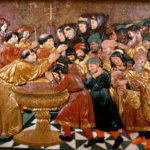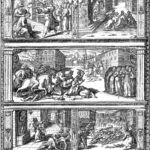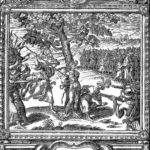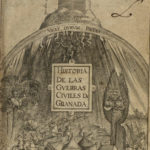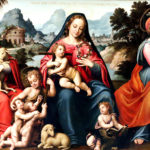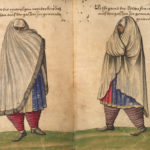Portraying conversion — Franco
By Borja Franco | Published on October 7, 2019
My research project begins with a question: is it possible to visually represent religious conversion? More specifically, was it feasible to depict the conversion of the Moriscos in early modern Spain? To date, there has been no attempt to study how artists dealt with the problem of representing the converso population and making it visible.
In my work, I start from the premise that neither ethnic appearance nor costume allow us to accurately identify these figures. I therefore begin to untangle the problem by analyzing the thorny issue of the ethnic representation of Moriscos in painting, prints, drawings, and sculpture. Scholars like Vincent (1985), Fuchs (2002–9), or Feros (2017) have shown that Moriscos were described in legal and literary sources as either dark or white skinned to justify the similarity between old and new Christians. More specifically, our most recent publication (Franco–Díaz del Campo, 2019) shows, using census data from the years following the War of the Alpujarras, that the number of dark-skinned Moriscos was only slightly higher than that of light-skinned ones as a result of years of coexistence with Old Christians. It is therefore easy to understand why different texts dating from the time of the expulsion state that Moriscos were indistinguishable from the rest of the population.
On the other hand, Spanish sources also suggest a conspicuous hybridization of customs between these groups, including attire. For instance, “dressing as a Moor” was not necessarily a token of religious alterity but could in fact be a sign of luxury (Irigoyen 2017). Such ambiguity renders the task of visualizing the Morisco even more difficult.
Approaching the converso through the lens of difference is a fundamental mistake because it distorts complex and diverse realities. My research addresses a number of questions that have not been adequately answered: What kind of image was in the mind of an artist who created pictorial cycles showing Moriscos? To what extent were artists depicting the reality of that minority, or was their aim simply to contribute to the social construct to which the Morisco was subject?
I propose five ways to pursue these questions:
- The Morisco as a Spaniard: I begin the discussion with Felipe Bigarny’s altarpiece in Granada’s Royal Chapel (1526) displaying scenes of the Baptism of Granadan Moriscos. The subjects were portrayed with both light and dark complexions in order to show their ethnic diversity, but in my opinion, they were represented as subjects of the Spanish Empire and integrated under its rule. (Figs. 1–2) They appear dressed in their regional attire – which caught the attention of central European travelers – to make them easily identifiable. (Fig. 3) The issue of the Morisco as a member of the Spanish nation has been researched by several scholars, including Fanjul (2013), Feros (2017), Herzog (2003) or Bernabé Pons (2017). The prevailing view among the scientific community is that they were generally considered to be as Spanish as Old Christians, as can be seen in the writings of Pedro de Valencia and the text of Don Quixote, although some historians refute this by focusing on the thoughts of the apologists of expulsion. The image of ethnic diversity displayedon the Granada altarpiece fits in with the imagery used to represent the Morisco collective on the seventh of the commemorative arches built in Seville on the occasion of Charles V’s marriage to Isabella of Portugal in 1526. In these works, the converso appears surrounded by Indians, Germans, Italians and other Spaniards to convey the idea that they all were part of the Hispanic nation. The positive message contained in these two roughly contemporary works was consistent with Charles V’s assimilationist policy.
- The Morisco as a Turk: In certain artworks, such as Francisco Heylan’s and Girolamo Lucenti’s illustrations in Historia Eclesiástica by Justino Antolínez (1610), converts are represented as Turkish allies, mainly as a response to the violence unleashed during the War of the Alpujarras (1568–1571). Coastal security problems involving Barbary pirates also contributed to this association. In this case, Moriscos were depicted as Turks to show that they were not true Christians, but enemies of the Spanish monarchy (Figs 4–5). This current was essentially a visual expression of the theories that had been evolving in courtly circles since the mid sixteenth century, particularly among those who loudly demanded the expulsion of Moriscos. It is interesting to note that this current was not visually captured until much later, by and large after the expulsion, as for instance in the works mentioned above or in Petrus Firens’ illustrations for the flyleaf of Pérez de Hita’s work Las Guerras de Granada (The Granada Wars).
- The “racialized” Morisco: The canvases painted by Pere Oromig, Vicente Mestre, and Jacinto de Espinosa to illustrate Morisco expulsions from Valencia in 1609 all show dark-skinned Moriscos. This representation echoes Philip III’s justification of the expulsion as a confrontation between white Christians and black crypto-Muslims (Figs 6–7). The aim of this distorted and racialized image was to prove that Moriscos were not Spaniards. In these images they were Africanized, portrayed as Berber tribesmen, and made to resemble the enemy. This process of “racialization” challenges the “realism” of these images. Bigarny’s altarpiece in Granada and this set of paintings illustrate opposite ends in the process of creating alterity. They demonstrate that the image of Morisco “others” does not always emerge as a reflection of reality, but as an expression of the political and religious concerns of their contemporaries.
- The Morisco in the eyes of travelers: A significant part of historiographical research to date considers the descriptions and illustrations of Moriscos by such authors as Weiditz (Fig. 3) or Hoefnagel to be reliable sources. Our research in the archives, however, has found this to be another instance of a mental construct created by intellectuals traveling to the Iberian Peninsula, lured by its “exoticism” and Islamic heritage. These images selectively display characters drawn from the most deeply Islamicized backgrounds, thereby creating clichés that do not agree with what we find in primary sources, be it as regards Morisco dress or even skin color. In this instance the representations were not driven by political interest but chiefly by the travelers’ subjective interpretation.
- The hidden Morisco: My work on crypto-Muslim representations is perhaps the most ground-breaking aspect of this research. Certain paintings by the artist Joan de Joanes convey a salvific message in the representation of Moriscos as innocents, arguing that they did not choose to be born infidels. This idea is linked to the humanist J. B. Agnesio, an important preacher to Moriscos, who was connected to the prominent Centelles and Borja families. Agnesio was a passionate advocate of peaceful conversion by adopting the methods previously used by Hernando de Talavera. This leads us to conclude that in these works the Morisco is portrayed through subtle metaphors that emphasize the need for personalized preaching. This imagery widens the range of representations of the Morisco minority, as it includes more complex ways to symbolically describe the “other” (Fig. 8).
Briefly, my research suggests an approach to the study of visual representations of Moriscos, ranging from those images that were used to stigmatize the group or justify their expulsion, to those that broadcast a moral message about their duty to be true Christians, whilst at the same time concealing their identity.
The aim of this research is to give a voice to these works of art, not as mere visual depictions of a text, but as constituent elements of a society that expressed its anxieties through them. My discourse springs from the need to rethink the way our past has been studied so far and, in particular, to reflect on how a stereotyped imagery of Christian converts from Islam was created which did not always agree with reality. Works of art should be seen as sources to be studied in parallel with — rather than superimposed over — textual sources, be they of a literary or legal nature. Only when all the pieces in the puzzle are in place, we shall be able to “see” the Moriscos in a different light and to understand the ways in which this collective was imagined and used, sometimes for political purposes. Only then shall we be closer to understanding the difference between the “real” and the “made-up” Morisco, whatever the reasons behind its creation.


